Eggplant, the birthplace of which is India, can be successfully grown on a personal plot in a polycarbonate greenhouse even in the conditions of the Urals of Siberia. It is difficult to overestimate the use of vegetables for the body, and therefore gardeners willingly plant eggplants in a greenhouse, the cultivation and care of which are not difficult with a competent approach.
Material Content:
Eggplant - the best greenhouse varieties
Not all varieties are suitable for indoor cultivation. The effectiveness of garden work depends on how correctly the variety is selected. The following F1 eggplant varieties are popular for greenhouses.
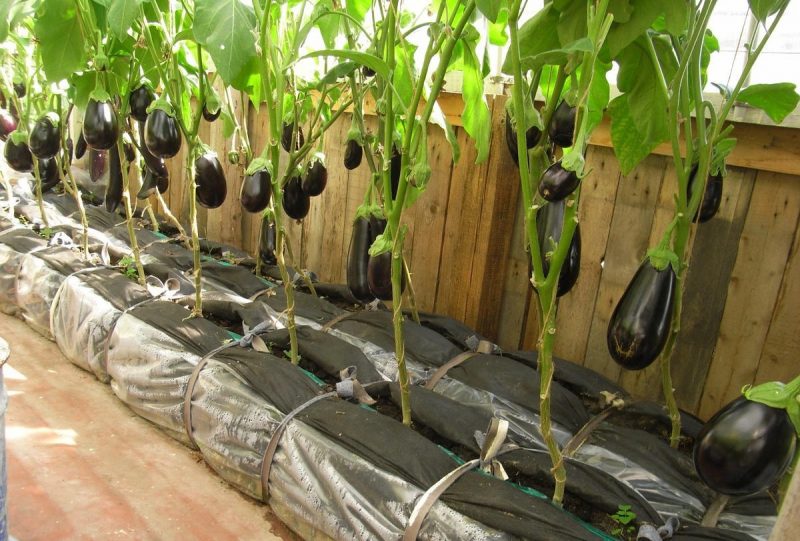
Early ripening:
- Boyarin;
- Ekawi.
Medium Early:
- Bard;
- Goliath;
- Bagheera;
- Baikal.
Precocious:
- Northern blues.
Of non-hybrid varieties of eggplant for growing indoors, preference should be given to the following:
Early ripening:
- Vacula
- Sperm whale.
Medium Early:
- Philemon;
- Dolphin;
- Half a half;
- Lolita
The specific choice of variety depends on the personal preferences of the gardener. You can choose a variety with fruits of a traditional color, as well as white or white-purple.
Preparing an eggplant greenhouse
A polycarbonate greenhouse allows you to create optimal growth conditions for the plant, under which the fruits will ripen qualitatively. If an expensive design with heating is used, the seedlings are planted early.In a simpler version, which is used by almost all gardeners, eggplants are planted only after a stable plus is established, which in most regions, with the exception of the southern ones, occurs only at the end of May. The thicker the carbonate used to cover the greenhouse, the earlier it will be possible to plant a crop in it.
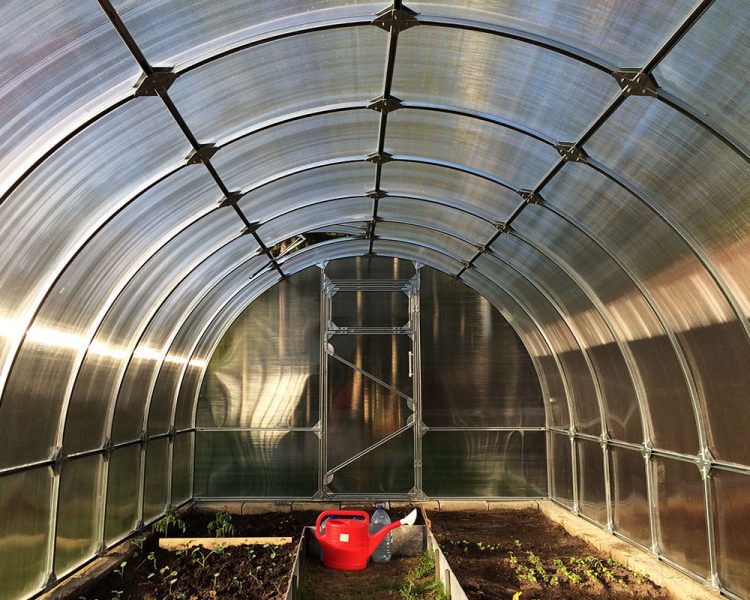
Preparing a greenhouse for planting seedlings is not difficult. The main stages are:
- heating connection - in structures that are designed for this;
- greenhouse disinfection - for this it is convenient to use a sulfur block. After such exposure, there is no need to fear outbreaks of disease;
- watering the soil after winter - during the cold period, the soil manages to dry out very much, and to restore the normal state in which the life of most bacteria, as well as earthworms, is possible, it must be saturated with moisture.
Optimal use of the greenhouse is only for eggplant. When this is impossible due to the lack of space, we can allow their proximity, but only with certain cultures, which will be described in more detail below.
Growing seedlings at home
From the quality of growing seedlings, the yield of plants depends in the future. Seeds are planted 70 days before the intended transplantation of eggplant to a permanent place. It is important to focus on the weather in a particular region. The soil at the time of planting should not be colder than +15 C, and air +17 C.
The seeds for disinfection are soaked in a solution of manganese for 20 minutes, after which they are planted individually in cups filled with special soil for eggplant, which is sold in garden stores. Before seed germination, the cups are kept under polyethylene to create a greenhouse effect. The film is removed after emergence. Caring for eggplant before planting in the ground is similar to caring for seedlings of other crops. Watered as necessary, preventing moisture from getting on the sprouts. During the period of growing seedlings, fertilizing with phosphorus-potash fertilizers is carried out 1 time.
Read also:eggplant rolls with different fillings
Planting eggplant in a polycarbonate greenhouse
Transplanting is a serious stress for plants, in which mistakes made can lead to their death.
How and when to plant?
Planting seedlings is carried out after a persistent plus is established, and the soil warms up sufficiently.
The soil in the greenhouse is well dug, they prepare holes in it with a depth of 20 cm. 2 liters of weak, slightly pink manganese solution are poured into each. If the eggplant was grown in peat pots, then directly in them the seedlings are put in the holes and sprinkled with earth, slightly compacted in order to fix the plant in the soil. Next, carry out watering with warm water in a volume of 1 liter for each bush seedlings. Peat cups will gradually become limp in the soil, and eggplants will not experience stress due to transplantation.
When the seedlings are grown in insoluble containers, then they are abundantly watered before extraction. Then the eggplant is carefully removed from the pot, placed in the hole, being careful not to injure the root system. If some roots break, it is better to trim them carefully.
With any method of planting seedlings, to prevent decay of the lower part of the stem, it must be covered with soil exactly 1 cm higher than it was in the pot.
What can I plant?
Growing eggplant with other crops is highly undesirable. In the event that it is impossible to allocate an individual greenhouse for a plant, eggplant should be planted only with neighbors who can tolerate strong soil moisture and high temperatures. The best combination is eggplant and peppers or cucumbers. If peppers are selected, it is important to remember that it is impossible to combine their various types in one greenhouse, they will become dusty.
It is strictly forbidden to plant eggplant together with tomatoes.They have radically different needs for water, and therefore either the former will dry out, or the latter will rot.
Soil requirements

For the full growth of eggplant, the temperature of the earth should not be lower than +15 C. The soil plants need loose and light, which ensures high-quality root respiration. The acidic soil for the eggplant is destructive. If its acidity in the greenhouse is increased, then to lower it is necessary to add chalk or dolomite flour at the rate of 60 g per 1 m2. Also, plants should receive a sufficient amount of nutrients. It is optimal to put rotted horse manure into the soil at the rate of 2.5 liters per 1 m2. To enrich the soil with minerals, wood ash is added to it according to the norm: a bucket of 5 l per 1 m2.
Eggplant care in greenhouse conditions
After planting, eggplant requires competent care, without which they will begin to wither.
Temperature mode
The temperature in the greenhouse is of great importance when growing crops. If the warming is below the required, then the plants will stop developing, and if excessively high, they will burn. It is optimal for eggplant to maintain the air temperature in the greenhouse at a level of +25 to + 28 C. To control the temperature, you should have two thermometers. One is located at the soil level, and the second at the top of the plants.
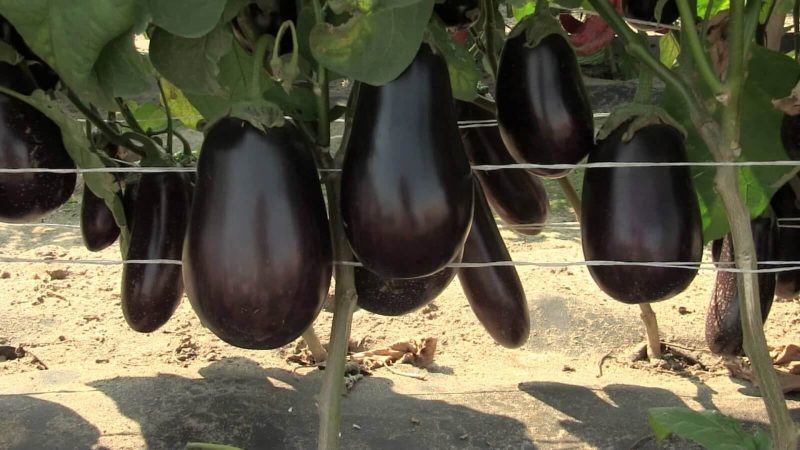
When it is necessary to lower the temperature, the greenhouse is aired and humidified. To increase the temperature, they close the doors and windows.
Watering and feeding
Watering and crusting eggplant should be consistent with the needs of the plants. If the air humidity is low, then after morning watering, the soil is mulched with straw. Eggplant is poured under the root. Humidification of the earth is required plentiful, so that the roots could not drink normally at a depth of 20 cm. Watering is needed as needed. The earth should always be moist, but not too wet, since an excess of moisture causes the fruits to be chopped.

Feeding is carried out according to a certain schedule. The first - 14 days after transplanting to a permanent place. For her, it is better to use the agent "Azofoska", which is bred in the amount of 3 tbsp. l for 10 liters of water. Under each plant, pour 500 ml of the solution. When the ovary has formed, a second dressing is carried out with a solution of mullein in water at a rate of 1:10. The third top dressing is external or extra root. It is necessary at the time of fruit growth, for which the bushes are sprayed with the drug "Ovary". Fertilizers should be used to the extent recommended in the instructions. Overfeeding the plant has an extremely negative effect on yield and quality of the fruit.
Loosening and tying
Loosen the soil around the plant the next day after watering to avoid the formation of a crust, which makes root breathing difficult. Processing is carried out to a depth of 5 cm.
Eggplant shoots are fragile, which is why they must be tied to a support to prevent damage to the bush under the weight of the fruit. For supports it is more convenient to use strong columns. Varieties with a compact bush are stronger and do not need a garter. In the event that the fruit grows so large that there are fears for the plant, even with high-quality tying, it is better to put a box under the ripening eggplant that will support it, reducing the load on the stem.
Formation of a plant in a greenhouse
Shrubs are not required for most varieties. The main thing when caring for a plant is to remove yellowed leaves and fruits with deformations from it in time. Stepsoning is carried out at the request of the gardener.
How to pinch eggplant?
Sometimes gardeners can pinch eggplant in order to obtain the largest possible fruits. For this, at the moment when shoots without buds are actively appearing in the leaf sinuses, their removal is required before the first shoot with buds. Further damage to plants is highly discouraged.
The main problems associated with growing
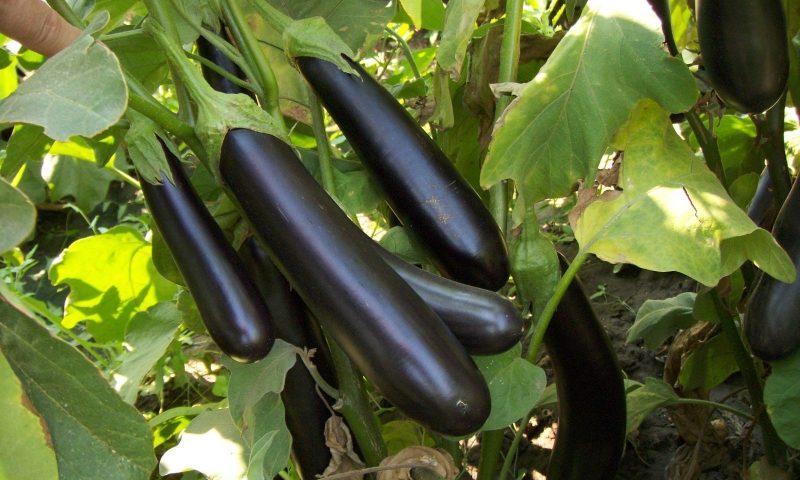
Subject to agricultural technology, problems should not arise in the cultivation of crops. In some cases, in adverse weather conditions, difficulties may arise in maintaining a good temperature and humidity conditions. For gardeners with a small plot, the main problem when growing eggplants is the limited number of crops that can be adjacent to them.
Eggplant diseases and pests
If the aubergines turn yellow and change their appearance, attention must be paid to the presence of diseases or pests. Both that and others can completely destroy landing. The main diseases of the culture are several.
- Blackleg - fungal infection, in which constriction and blackening of the basal neck develops. Plants quickly wilt due to the transition of the fungus to the root system.
- Tobacco mosaic - a viral disease from which a plaque appears in the form of a mosaic on the leaves of a plant. Yellow blotch develops on the fruits. Due to the disease, up to 15% of the total yield is lost.
- Gray rot - a fungal disease that develops especially rapidly with high humidity. Sick plants must be urgently treated with special antifungal drugs, and in case of severe damage - completely removed from the greenhouse.
- Late blight - a fungal disease that, after infection, quickly destroys the plant. It is transmitted through seeds, plant debris and soil.
Pests can attack the culture. Aphids on eggplants are especially common. Spider mites, slugs and snails can also affect plants. From all these pests, Strela is used, which is completely safe for humans.
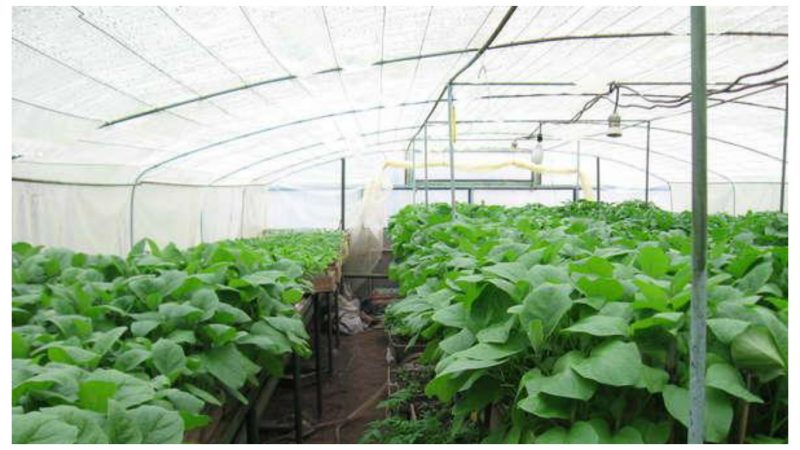
Growing eggplant is an interesting activity, which allows you to get healthy vegetables of high quality on your site.












